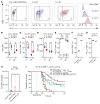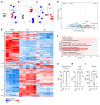IL-7-mediated expansion of autologous lymphocytes increases CD8+ VLA-4 expression and accumulation in glioblastoma models
- PMID: 40244705
- PMCID: PMC12165802
- DOI: 10.1172/JCI181471
IL-7-mediated expansion of autologous lymphocytes increases CD8+ VLA-4 expression and accumulation in glioblastoma models
Abstract
The efficacy of T cell-activating therapies against glioma is limited by an immunosuppressive tumor microenvironment and tumor-induced T cell sequestration. We investigated whether peripherally infused nonantigen specific autologous lymphocytes could accumulate in intracranial tumors. We observed that nonspecific autologous CD8+ ALT cells can indeed accumulate in this context, despite endogenous T cell sequestration in bone marrow. Rates of intratumoral accumulation were markedly increased when expanding lymphocytes with IL-7 compared with IL-2. Pretreatment with IL-7 ALT also enhanced the efficacy of multiple tumor-specific and nontumor-specific T cell-dependent immunotherapies against orthotopic murine and human xenograft gliomas. Mechanistically, we detected increased VLA-4 on mouse and human CD8+ T cells following IL-7 expansion, with increased transcription of genes associated with migratory integrin expression (CD9). We also observed that IL-7 increases S1PR1 transcription in human CD8+ T cells, which we have shown to be protective against tumor-induced T cell sequestration. These observations demonstrate that expansion with IL-7 enhances the capacity of ALT to accumulate within intracranial tumors and that pretreatment with IL-7 ALT can boost the efficacy of subsequent T cell-activating therapies against glioma. Our findings will inform the development of future clinical trials where ALT pretreatment can be combined with T cell-activating therapies.
Keywords: Cell migration/adhesion; Immunotherapy; Neuroscience; Oncology; T cells.
Figures







Similar articles
-
Osteopontin mediates glioblastoma-associated macrophage infiltration and is a potential therapeutic target.J Clin Invest. 2019 Jan 2;129(1):137-149. doi: 10.1172/JCI121266. Epub 2018 Nov 19. J Clin Invest. 2019. PMID: 30307407 Free PMC article.
-
The AURKA inhibitor alters the immune microenvironment and enhances targeting B7-H3 immunotherapy in glioblastoma.JCI Insight. 2025 Feb 10;10(5):e173700. doi: 10.1172/jci.insight.173700. JCI Insight. 2025. PMID: 39928563 Free PMC article.
-
GCN2 is essential for CD8+ T cell survival and function in murine models of malignant glioma.Cancer Immunol Immunother. 2020 Jan;69(1):81-94. doi: 10.1007/s00262-019-02441-6. Epub 2019 Dec 16. Cancer Immunol Immunother. 2020. PMID: 31844909 Free PMC article.
-
Follicular helper-T cells restore CD8+-dependent antitumor immunity and anti-PD-L1/PD-1 efficacy.J Immunother Cancer. 2021 Jun;9(6):e002157. doi: 10.1136/jitc-2020-002157. J Immunother Cancer. 2021. PMID: 34103351 Free PMC article.
-
Crosstalk Between Tumor-Associated Microglia/Macrophages and CD8-Positive T Cells Plays a Key Role in Glioblastoma.Front Immunol. 2021 Jul 29;12:650105. doi: 10.3389/fimmu.2021.650105. eCollection 2021. Front Immunol. 2021. PMID: 34394072 Free PMC article. Review.
References
MeSH terms
Substances
Grants and funding
LinkOut - more resources
Full Text Sources
Medical
Research Materials

